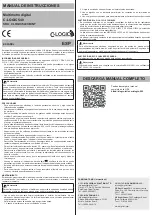
7. Diode Test (Picture 10)
1) Insert the red test lead into the or terminal, and black test lead
into the
COM
terminal.
2) Turn the function dial to the or position.
3) Short press the
button to switch to diode test if required.
SELECT
4) Connect the red probe with the diode anode, and black probe with the diode
cathode.
5) Read the forward bias value on the display.
6) Measured value <0.12V: The diode may be damaged; the red indicator light
is on.
Measured value within 0.12V~2V: The diode is normal; the green indicator
light is on (for reference only).
7) If the diode is open or its polarity is reversed, the LCD will display “OL”. For
silicon PN junction, the normal value is generally about 500~800 mV.
Caution:
Use caution when working with voltages above AC 30Vrms, 42Vpeak or DC 60V.
Such voltages pose a shock hazard.
Before testing the diode, switch off the power supply of the circuit, and fully
discharge all capacitors.
8. Capacitance Measurement (Picture 11)
1) Insert the red test lead into the or terminal, and black test lead
into the
COM
terminal.
2) Turn the function dial to the or position.
3) Short press the
button to switch to capacitance measurement.
SELECT
4) Touch the probes to the capacitor pins.
5) Read the capacitance value on the display after it gets steady.
Caution:
Use caution when working with voltages above AC 30Vrms, 42Vpeak or DC
60V. Such voltages pose a shock hazard.
Before measuring, fully discharge all capacitors (especially high-voltage
capacitors) to avoid damage to the meter and user.
If the measured capacitor is short-circuited or the capacitance exceeds the
maximum range, the LCD will display “OL”.
When measuring high capacitance, it is normal to take a few seconds to
stabilize the reading.
For small capacitance measurement, the REL mode should be used to avoid
the influence coming from distributed capacitance so as to obtain the correct
reading.
Picture 11
Picture 10





































